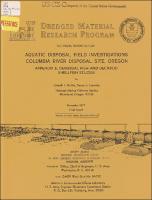Please use this identifier to cite or link to this item:
https://hdl.handle.net/11681/47659| Title: | Aquatic disposal field investigations, Columbia River disposal site, Oregon : appendix E, demersal fish and decapod shellfish studies |
| Authors: | Durkin, Joseph T. Lipovsky, Sandy J. |
| Keywords: | Aquatic ecology Sedimentation and deposition Sediment transport Dredging Dredging spoil Dredged material Columbia River Fish populations Shellfish populations Dredged Material Research Program (U.S.) |
| Publisher: | U.S. Army Engineer Waterways Experiment Station |
| Series/Report no.: | Technical Report (Dredged Material Research Program (U.S.)) ; no. Technical Report D-77-30; Appendix E |
| Abstract: | Information is provided on 51 finfish and 13 decapod shellfish found at five sites off the Columbia River mouth. The effects of a controlled sediment release by hopper dredges on these indigenous species were studied between October 1974 and April 1976. An initial nine-month phase provided biological in-formation at four sites with a fifth site included in July 1975, as an experimental deposition area. The dredges HARDING and BIDDLE released 548,519 m³ of sediment between July 9 and August 26, 1975. Sampling continued during and after sediment release until April 1976. Trawling effort consisted of 151 tows 5 minutes in duration and yielded 86,931 finfish and 97,360 decapod shellfish. Numerically important were anchovy, smelt, sole, poachers, snailfish, shrimp, crab, tomcod, and sanddab. Nonparametric test indices of community diversity usually decreased at the experimental test site during and after sediment deposition. However, diversity indices subsequently recovered and were comparable to those of the other sites by April 1976. Characteristics of dominant species are described including size range, food preference, and seasonal availability. Using data on dominant species, statistical tests indicated catch differences usually occurred between sites and between months; further, individuals at the test site were smaller. Tests were limited by small numbers of species and individuals taken at the test site during and after sediment deposition. Finfish food studies revealed preferential feeding habits. Five organisms were extensively consumed and included a cumacean, amphipod, mysid, shrimp, and anchovy. Changes in fin-fish food utilization were difficult to assess, but consumption of small organisms diminished and utilization of shrimp and anchovy increased. Data indicate that substantially more finfish and decapod shellfish reside at north and central sites during normal channel maintenance periods. The experimental release of sediments was detectable by diversity indices. |
| Description: | Technical Report |
| Gov't Doc #: | Technical Report D-77-30; Appendix E |
| Rights: | Approved for Public Release; Distribution is Unlimited |
| URI: | https://hdl.handle.net/11681/47659 |
| Appears in Collections: | Technical Report |
Files in This Item:
| File | Description | Size | Format | |
|---|---|---|---|---|
| Technical Report D-77-30 Appendix E.pdf | 8.39 MB | Adobe PDF |  View/Open |